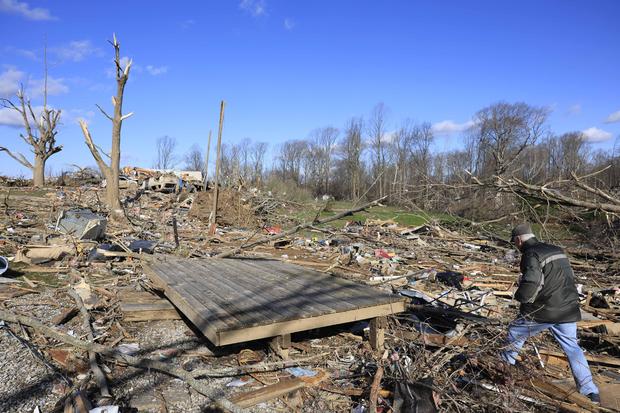2023's tornado death toll is approaching the average normally seen in a full year
A fierce string of tornadoes ripped across the United States this past week, killing dozens and leaving a trail of destruction in its wake.
Homes and buildings were reduced to rubble as twisters tore through wide sections of the South, Midwest and parts of the Northeast. Reports of people trapped beneath the debris of destroyed homes emerged in Alabama and Arkansas, while residents of a town west of Memphis said they woke up Sunday morning to find the local high school building in ruins. In Illinois, one person died and several others were hurt when a storm system hit the area on Friday night and caused the roof of a packed theater to collapse.
At least 33 people were killed in tornadoes that struck last weekend alone, with at least five more deaths reported in southeastern Missouri on Wednesday, after a tornado hit just before dawn, officials said.
The latest series of deadly storms brought the overall death toll linked to tornadoes to at least 63 people just this year, a spokesperson for the National Oceanic and Atmospheric Administration confirmed to CBS News on Wednesday afternoon. That number accounts for tornado-related deaths recorded nationwide since the beginning of 2023, and it already comes quite close to the average U.S. death toll usually recorded over the course of 12 months.
"It has been unusually busy with tornadoes since the beginning of the year," Jacqui Jeras, a meteorologist at The Weather Channel, told CBS News on Thursday, citing a fairly persistent upper-level weather pattern that is conducive to severe storms. Jeras suggested the uptick could be a consequence of La Niña, a set of climate conditions that refers to how cooler temperatures in the Pacific Ocean change global weather patterns.
"Our busiest tornado seasons are typically during La Niña," she said.
Based on 30 years of data collected between 1993 and 2022, the average annual death toll linked to tornadoes is 71 people in the U.S., according to the National Weather Service. The agency's Storm Prediction Center has reported the highest incidences of fatal twisters in Alabama, Missouri, Tennessee, Oklahoma and Georgia, where the average death tolls are 14, eight, seven, five and five, respectively. Arkansas, Kentucky, Mississippi and Texas follow closely behind with four deaths each, on average, per year.
Several of those states have already confirmed tornado-related deaths in numbers that hover around their annual averages. Even in Delaware, which has recorded zero annual deaths on average linked to tornadoes, a suspected twister caused a structure to collapse near the town of Greenwood on Saturday night, killing at least one person, the local government said at the time.
"The death toll is up for a couple of reasons," Jeras explained. "Obviously, the more tornadoes you have, the greater the risk of deaths. But, the number of deaths is higher when the tornadoes are stronger. We have also had a lot of nighttime, or nocturnal tornadoes, which are twice as likely to be deadly. "
A sizeable jump this year
The National Weather Service keeps track of particularly devastating storms — which the agency classifies as "killer tornadoes" — as they occur each year across the country. Weather service data shows it is relatively uncommon for storms of this magnitude to occur in clusters, although it is not unheard of. In April 2020, for example, the agency recorded 13 "killer tornadoes" over the course of one month.
"Tornado season" typically reaches its peak in the late spring or summer, depending on the region, although scientists have said that, under appropriate conditions, a tornado could occur at any time, anywhere in the U.S. Still, Jeras noted that "tornadoes are most frequent in the spring months as the season is changing," and April "kicks off the most dangerous three-month period for tornadoes."
During the spring season, greater contrasts in air masses and dips in the jet stream give rise to "cooler, drier air meeting up with the warm, moist air from the Gulf of Mexico," she told CBS News. These atmospheric conditions can create tornadoes that are stronger, more long-lasting and more destructive.
The elevated death toll reported this year has come alongside an unusually high incidence of tornadoes, according to National Weather Service records. Between January 1 and April 5, 2023, the agency confirmed at least 367 tornadoes, said Matthew Elliott, a warning coordination meteorologist for the agency's storm prediction center, in an email to CBS News on Wednesday afternoon.
That preliminary number differs slightly from the one that appears on the storm prediction center's website, which reflects the 422 eyewitness reports of tornadoes that the weather service received from the top of the year until Monday. The initial sum is often an overestimate, "as the same tornado can be reported multiple times," especially when a tornado has a longer track, Elliott said. After reports are submitted, officials conduct land surveys to determine whether or not a tornado actually happened.
The 367 tornadoes confirmed through those surveys by Wednesday, in as many as 25 states, marked a sizable jump from the number of storms usually recorded by this time in a given year. Based on weather service data that tracked actual tornadoes in any state between January and early April over the last four years, the number represents at least a 53% increase in tornadoes compared with the four-year average, which is roughly 239 storms.
A closer look at the data shows some years were more severe than others, with officials recording 502 tornadoes nationwide by the end of April 2022. One year earlier, the National Weather Service confirmed just 243 tornadoes over the same time period, although cumulative tallies recorded by the end of April in 2020 and 2019 were similar to last year's.
The effects of climate change
Despite some variability year to year, the brutal tornadoes that have wreaked havoc since the end of March fueled recurring questions about a potential relationship between climate change and the frequency, severity and location of tornadoes in the U.S.
"I think that climate change may be playing a role in the intensity and frequency of tornadoes," said Jeras, noting how "in recent years we are seeing the area where tornadoes occur most often changing," and "tornado alley" — a broad stretch of the U.S. typically associated with twisters — "may need to be adjusted."
Officials warn that deciphering any pattern in tornado activity is complex since the formal record only dates back about seven decades and the weather service does not release its final monthly incident tallies until 75 days after each month has ended. But, while scientists cannot say with certainty that a causal link exists between warming temperatures and tornado activity, they have acknowledged that climate change could influence and possibly exacerbate the atmospheric conditions necessary for a tornado to occur.
Scientists at NOAA said human-caused climate change could play a role in "changes in tornado activity" in a 2019 report assessing their relationship. The report noted that tornado activity depends mainly on "the strength of atmospheric instability" and "vertical wind shear, which provides the necessary rotation for tornadic thunderstorms." Temperature variations linked to climate change influence both of those things, the scientists said.
"While early indications suggested a likely tug-of-war between these two mechanisms, recent studies have shown an overall increase in the projected number of days where sufficient instability and wind shear occur in tandem," they wrote in the report.
Results of a more recent study published by the Bulletin of the American Meteorological Society in January found that warming climates could contribute to more frequent supercell thunderstorms in the future, which may occur outside of the traditional storm season. Since intense supercell storms can produce a range of severe weather events, including tornadoes, the study's authors said its results "suggest the potential for more significant tornadoes, hail, and extreme rainfall that, when combined with an increasingly vulnerable society, may produce disastrous consequences."





